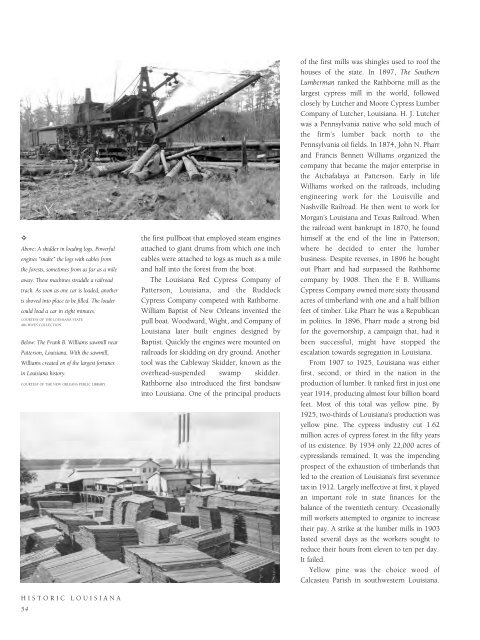Historic Louisiana
An illustrated history of Louisiana, paired with the histories of companies, families and organizations that make the state great.
An illustrated history of Louisiana, paired with the histories of companies, families and organizations that make the state great.
You also want an ePaper? Increase the reach of your titles
YUMPU automatically turns print PDFs into web optimized ePapers that Google loves.
✧<br />
Above: A skidder in loading logs. Powerful<br />
engines “snake” the logs with cables from<br />
the forests, sometimes from as far as a mile<br />
away. These machines straddle a railroad<br />
track. As soon as one car is loaded, another<br />
is shoved into place to be filled. The loader<br />
could load a car in eight minutes.<br />
COURTESY OF THE LOUISIANA STATE<br />
ARCHIVES COLLECTION.<br />
Below: The Frank B. Williams sawmill near<br />
Patterson, <strong>Louisiana</strong>. With the sawmill,<br />
Williams created on of the largest fortunes<br />
in <strong>Louisiana</strong> history.<br />
COURTESY OF THE NEW ORLEANS PUBLIC LIBRARY.<br />
the first pullboat that employed steam engines<br />
attached to giant drums from which one inch<br />
cables were attached to logs as much as a mile<br />
and half into the forest from the boat.<br />
The <strong>Louisiana</strong> Red Cypress Company of<br />
Patterson, <strong>Louisiana</strong>, and the Ruddock<br />
Cypress Company competed with Rathborne.<br />
William Baptist of New Orleans invented the<br />
pull boat. Woodward, Wight, and Company of<br />
<strong>Louisiana</strong> later built engines designed by<br />
Baptist. Quickly the engines were mounted on<br />
railroads for skidding on dry ground. Another<br />
tool was the Cableway Skidder, known as the<br />
overhead-suspended swamp skidder.<br />
Rathborne also introduced the first bandsaw<br />
into <strong>Louisiana</strong>. One of the principal products<br />
of the first mills was shingles used to roof the<br />
houses of the state. In 1897, The Southern<br />
Lumberman ranked the Rathborne mill as the<br />
largest cypress mill in the world, followed<br />
closely by Lutcher and Moore Cypress Lumber<br />
Company of Lutcher, <strong>Louisiana</strong>. H. J. Lutcher<br />
was a Pennsylvania native who sold much of<br />
the firm’s lumber back north to the<br />
Pennsylvania oil fields. In 1874, John N. Pharr<br />
and Francis Bennett Williams organized the<br />
company that became the major enterprise in<br />
the Atchafalaya at Patterson. Early in life<br />
Williams worked on the railroads, including<br />
engineering work for the Louisville and<br />
Nashville Railroad. He then went to work for<br />
Morgan’s <strong>Louisiana</strong> and Texas Railroad. When<br />
the railroad went bankrupt in 1870, he found<br />
himself at the end of the line in Patterson,<br />
where he decided to enter the lumber<br />
business. Despite reverses, in 1896 he bought<br />
out Pharr and had surpassed the Rathborne<br />
company by 1908. Then the F. B. Williams<br />
Cypress Company owned more sixty thousand<br />
acres of timberland with one and a half billion<br />
feet of timber. Like Pharr he was a Republican<br />
in politics. In 1896, Pharr made a strong bid<br />
for the governorship, a campaign that, had it<br />
been successful, might have stopped the<br />
escalation towards segregation in <strong>Louisiana</strong>.<br />
From 1907 to 1925, <strong>Louisiana</strong> was either<br />
first, second, or third in the nation in the<br />
production of lumber. It ranked first in just one<br />
year 1914, producing almost four billion board<br />
feet. Most of this total was yellow pine. By<br />
1925, two-thirds of <strong>Louisiana</strong>’s production was<br />
yellow pine. The cypress industry cut 1.62<br />
million acres of cypress forest in the fifty years<br />
of its existence. By 1934 only 22,000 acres of<br />
cypresslands remained. It was the impending<br />
prospect of the exhaustion of timberlands that<br />
led to the creation of <strong>Louisiana</strong>’s first severance<br />
tax in 1912. Largely ineffective at first, it played<br />
an important role in state finances for the<br />
balance of the twentieth century. Occasionally<br />
mill workers attempted to organize to increase<br />
their pay. A strike at the lumber mills in 1903<br />
lasted several days as the workers sought to<br />
reduce their hours from eleven to ten per day.<br />
It failed.<br />
Yellow pine was the choice wood of<br />
Calcasieu Parish in southwestern <strong>Louisiana</strong>.<br />
HISTORIC LOUISIANA<br />
54
















